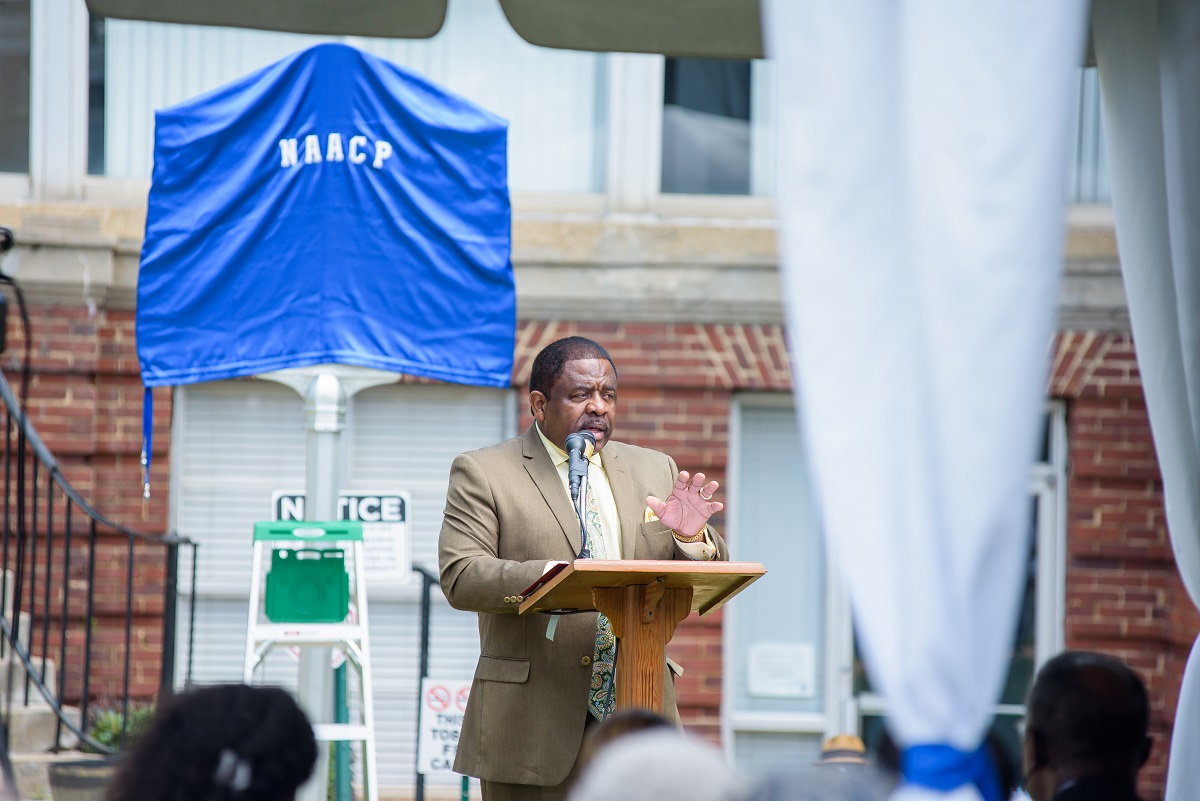New marker at Talladega College recognizes Alabama’s first NAACP chapter

Benard Simelton, president of the Alabama State Conference of the NAACP, stands with the NAACP's Terra Foster and Quentin Riggins, Alabama Power senior vice president of Governmental and Corporate Affairs, at the new historical marker that tells the story of the founding of Alabama's first NAACP chapter at Talladega College. (Nik Layman / Alabama NewsCenter)
A group of state and area dignitaries gathered Saturday in front of Seymour Hall on the campus of Talladega College to place a marker honoring a significant, if not particularly well-known, event from more than a century ago.
The first NAACP chapter in Alabama – or anywhere else in the Deep South – was established in 1913 at Talladega College.
This short-lived local chapter was established just four years after the national organization was founded in New York in 1909 and four years before any other Southern chapters were established.
The Talladega College chapter was largely the work of William Pickens, who enrolled in the college as a sophomore in 1898 and graduated in 1902. According to Dr. Dorothy Autrey, a Talladega College alum and retired professor of history and political science, Pickens distinguished himself as a scholar and orator during his time at Talladega and, after graduating, was named the college’s most distinguished graduate. He continued his studies at Yale, and joined the NAACP in 1910, less than a year after the organization was founded.
Pickens returned to Talladega College as a professor of German, Latin and Greek. He was noted as an able scholar and teacher, as well as an activist.
Unfortunately, Autrey said, Pickens’ activism was not viewed favorably by the college administration, which was all white at that time. College President John Metcalf said Pickens was spending too much time on activism and not enough time teaching, a statement that Autrey acknowledged was not entirely unfounded.
Historic marker recognizes Alabama’s first NAACP chapter at Talladega College from Alabama NewsCenter on Vimeo.
In 1914, not long after the Talladega College NAACP chapter was established, the college’s board of trustees accused Pickens of organizing a student strike and fired him. The chapter that he had established soon collapsed due to several factors, including the loss of its guiding force in Pickens, as well as general hostility from the larger community and the looming specter of World War I.
Pickens continued his activism, serving the NAACP as a field secretary and field director.
It was six years before another NAACP chapter was established in Alabama, “but the seed had been planted,” Autrey said. “Events at a small black college, in a little town in north Alabama, led to an organization that has forced us to face a history of racism and continues to fight for justice and equality for all.”
Blacks in Alabama, she said, “faced deeply entrenched racism, where they were denied the right to vote and where they faced rigid segregation. … Those in rural areas were exploited through sharecropping, and those in the cities were limited to unskilled and semiskilled labor and faced police brutality and the possibility of being lynched for showing even a hint of ‘uppity’ behavior.”
The Talladega College chapter left “no lasting legacy in and of itself,” Autrey said, “but did reflect the spirit of the organization and its founders in 1909.”
Even in the early 20th century, Birmingham, Mobile or Montgomery might have seemed to make better sense for the initial NAACP chapter, but Talladega had the college, which had grown to be highly respected after being established as a school for teachers by two former slaves in 1867. Theological studies were added in 1870, and the first college classes were offered in 1881.
The school, Autrey said, had gained a reputation for “academic excellence and the quality of its students.”
Talladega College President Billy Hawkins said he thinks of Pickens as “a change agent, a risk taker, an example of bold leadership. He was a game changer and a strength-focused leader. He stepped out there by himself. He was not afraid to step out by himself to bring about change.”
According to Benard Simelton, president of the Alabama State Conference of the NAACP, the state organization grew during the civil rights protests of the mid-1950s and early 1960s. In 1956, then-state Attorney General (later governor) John Patterson banned the organization from the state, “but that’s not how the story ended. In spite of having to pay a $100,000 fine, they fought on,” Simelton said.

Talladega College President Billy Hawkins speaks about William Pickens, a Talladega College professor and activist who founded Alabama’s first NAACP chapter there. (Nik Layman / Alabama NewsCenter)
Nine years later, in 1964, the U.S. Supreme Court overturned the ban and the state was “ordered to reinstate the organization with all rights and privileges.” Today, Simelton said, there are 35 fully compliant chapters in Alabama, more than 20 partly compliant chapters and at least a dozen youth and college chapters.
“We are fighting for voting rights, living wages and Medicaid expansion, against employment discrimination, for the rights to organize and protest, for equal access to the ballot and higher education, and to make Alabama the best that it can be,” he said.
Although Pickens was the primary focus of Saturday’s event, a great deal of appreciation was also directed toward Talladega County NAACP President the Rev. Hugh Morris, who was the driving force behind the placement of the marker.
“He would just walk into my office with no appointment,” Hawkins said, adding that Morris never lost sight of the goal of recognizing Pickens’ work, its significance in the life of the college and his legacy to current students.
Simelton also praised Morris’ persistence, adding that, as branch president, he was also “a voice for the voiceless” throughout Talladega County.
Talladega City Council President Betty Spratlin read a resolution honoring Morris.
The day’s other speakers included Dr. Adia Winfrey as mistress of ceremonies; Minister Greg Tankersley; LaTanga Morris; the Rev. Dontrell Curry; Josephine McKinney; Alabama NAACP Youth and College Division President Josh Thompson; Quentin Riggins, Alabama Power senior vice president of Governmental and Corporate Affairs; Talladega County Commission Chairman Kelvin Cunningham; and NAACP Director of Training Kevin Myles. Closing remarks were delivered by NAACP Alabama Conference Member Terra Foster. The benediction was offered by Talladega City Councilman Horace Patterson. Talladega High School JROTC presented the colors.
“We are used to having a lot of history here at this institution,” Hawkins said. “It is a history that we need to cherish.”
This story was originally published by The Daily Home.
















